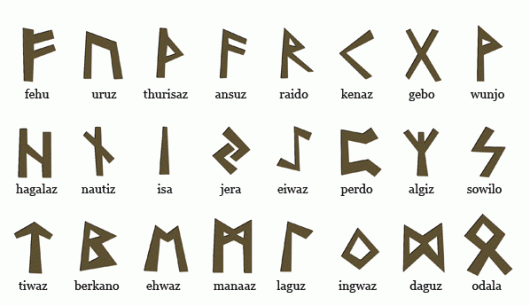Runic Alphabets
The three most popular runic alphabets are: Elder Futhark (approximately 150 to 800 A.D.)Anglo-Saxon Futhorc (400 to 1100 A.D.)Younger Futhark (800 to 1100 A.D.)
Runes Guide – Elder Futhark
This runic alphabet consist of 24 characters broken down into three groups of eight. These groups are called aett (or the plural aettir). For a chart listing these runes meanings see the exhibit labeled Rune Guide – Elder Futhark. The Elder Futhark is the most ancient of the Runic alphabets. It is named after the first six runes in the alphabet: F, U, Th, A, R and K). Knowledge of how to read this alphabet was lost for several centuries. In 1865 a scholar named Sopus Bugge was able to decipher it.
Rune Guide – Elder Futhark
Runes Guide – Anglo-Saxon Futhorc
The Anglo-Saxons and Frisians modified the letters of the Elder Futhark and increased the number of letters to between 26 and 33 to create what would become known as the Anglo-Saxon futhorc. The exhibit labeled Runes Guide – Anglo-Saxon futhorc displays the letters in this alphabet. The Anglo-Saxons brought the elder Futhark to England in the 5th century CE where they modified it. They modified it for use with the sounds of their language which was old English. An example of this is the word Futhorc. The Anglo-Saxons replaced the “a” with an “o” and the “k” with a “c”.
Runes Guide – Anglo-Saxon futhorc
Runes Guide – Younger Futhark
In the 9th century CE the Younger Futhark evolved. This alphabet adds the letter “R” and drops nine of the letters in the Elder Futhark. Many of the letters were now used to represent multiple sounds. The Younger Futhark is divided into two types short-twig (Swedish and Norwegian) and long-branch (Danish). Many scholars believe the short-branch runes were used in everyday life for messages on wood while the long-branch runes were used to inscribe on stone. Both versions of the Younger Futhark use 16 letters. For a chart listing these runes meanings see the exhibit labeled Runes Guide – Younger Futhark (Swedish and Norwegian) and the chart labeled Runes Guide – Younger Futhark (Danish). The cause of this reduction of letters in Younger Futhark is tied to very complex phonological changes that occurred in the old nordic language. As many old letters were removed from the alphabet, several of the remaining letters were overloaded to represent multiple sounds. The Younger Futhark was called the “alphabet of the Norsemen” in Europe. The Younger Futhark evolved further into the Marcomannic runes, the Medieval runes, and the Dalecarlian runes (around 1500 to 1800 AD).
Runes Guide – Younger Futhark (Swedish and Norwegian)
Runes Guide – Younger Futhark (Danish)
Courtesy of Viking Source




You post very interesting articles here.
Your website deserves much more traffic. It can go viral if you give it initial boost, i know very
useful tool that can help you, just search in google: svetsern traffic tips